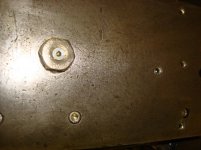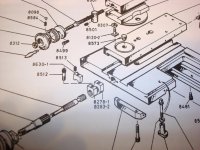Jason, great point about slop from the taper attachment, in fact in some designs it starts at the lowest casting. The Nardini TA is a case in point, the bottom casting in the pile, post #4 PN 969, is bolted to the rear of the saddle (
https://www.practicalmachinist.com/...rdini-taper-attachment-please-explain-159707/).
Being bolted direct to the saddle it is absolutely rigid, all good so far. Now we come up to PN 964, the longitudinal slide, is a source of movement in the slide between it and 969, there
has to be adjustable clearance for it to slide.
Now we come up to PN 963 which should be rigid being bolted to PN 964, but
it's slop is between it and the angled follower (My terms) PN 956 which has to have clearance to slide on it. Then on up to PN 957, the anchor for the screw's thrust bearings. From that point on all is well, but you can put a dial indicator on the slide of a Nardini and pull it towards and away from you and watch the needle dance!
Plus either you let that situation exist or tighten all the gibs until you need to use the attachment.
On mine (2 so far) I altered the design, and whether or not other telescopic attachments can be also altered is outside my knowledge.
PN 957 slides perpendicular to the bed inside PN 950, which is bolted and taper pinned to the saddle. The angled follower 957 has just enough room in it's corners looking down on it to drill/tap a couple 1/4-20 or 6 MM screws, these screws are flat headed type socket screws set catty cornered into that bearing block top, through the top of 950 which is countersunk for the screws. Between the bottom of 950 and the top of 957 I counterbored recesses for 1/2" OD washers, these washers were carefully surface ground to just take up the space between the two, and cannot get free because of the counterbore.
On top of 950 by the screws I stamped "Remove screws to use TA".
This effectively bypassed all the slop producing areas making a very rigid cross slide anchor out of it, in fact, you could take the TA off leaving PN 950 on holding the back of the bearing block and it would work nicely. Yet, as described you can take the two flat head screws out and setup your TA and use it too. Those two washers have to be bur free, but a bit of polish on the edges of them would help when used as a taper attachment.







